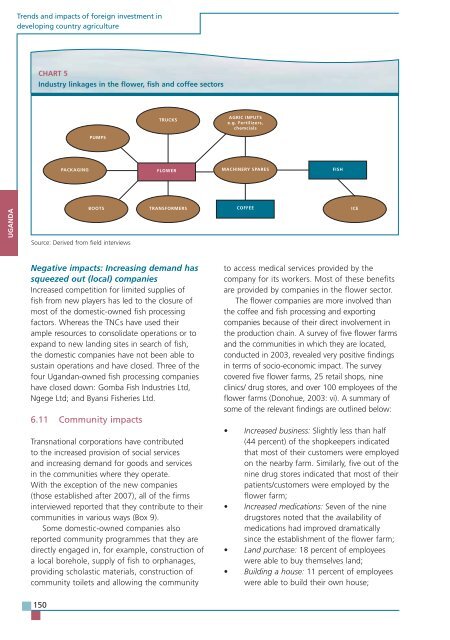TRENDS AND IMPACTS OF FOREIGN INVESTMENT IN DEVELOPING COUNTRY AGRICULTURE
TRENDS AND IMPACTS OF FOREIGN INVESTMENT IN DEVELOPING COUNTRY AGRICULTURE
TRENDS AND IMPACTS OF FOREIGN INVESTMENT IN DEVELOPING COUNTRY AGRICULTURE
You also want an ePaper? Increase the reach of your titles
YUMPU automatically turns print PDFs into web optimized ePapers that Google loves.
UG<strong>AND</strong>A<br />
Trends and impacts of foreign investment in<br />
developing country agriculture<br />
CHART 5<br />
Industry linkages in the flower, fish and coffee sectors<br />
Negative impacts: Increasing demand has<br />
squeezed out (local) companies<br />
Increased competition for limited supplies of<br />
fish from new players has led to the closure of<br />
most of the domestic-owned fish processing<br />
factors. Whereas the TNCs have used their<br />
ample resources to consolidate operations or to<br />
expand to new landing sites in search of fish,<br />
the domestic companies have not been able to<br />
sustain operations and have closed. Three of the<br />
four Ugandan-owned fish processing companies<br />
have closed down: Gomba Fish Industries Ltd,<br />
Ngege Ltd; and Byansi Fisheries Ltd.<br />
6.11 Community impacts<br />
Transnational corporations have contributed<br />
to the increased provision of social services<br />
and increasing demand for goods and services<br />
in the communities where they operate.<br />
With the exception of the new companies<br />
(those established after 2007), all of the firms<br />
interviewed reported that they contribute to their<br />
communities in various ways (Box 9).<br />
Some domestic-owned companies also<br />
reported community programmes that they are<br />
directly engaged in, for example, construction of<br />
a local borehole, supply of fish to orphanages,<br />
providing scholastic materials, construction of<br />
community toilets and allowing the community<br />
150<br />
PACKAG<strong>IN</strong>G<br />
PUMPS<br />
BOOTS<br />
Source: Derived from field interviews<br />
TRUCKS<br />
FLOWER<br />
TRANSFORMERS<br />
AGRIC <strong>IN</strong>PUTS<br />
e.g. Fertilizers,<br />
chemcials<br />
MACH<strong>IN</strong>ERY SPARES<br />
C<strong>OF</strong>FEE<br />
FISH<br />
to access medical services provided by the<br />
company for its workers. Most of these benefits<br />
are provided by companies in the flower sector.<br />
The flower companies are more involved than<br />
the coffee and fish processing and exporting<br />
companies because of their direct involvement in<br />
the production chain. A survey of five flower farms<br />
and the communities in which they are located,<br />
conducted in 2003, revealed very positive findings<br />
in terms of socio-economic impact. The survey<br />
covered five flower farms, 25 retail shops, nine<br />
clinics/ drug stores, and over 100 employees of the<br />
flower farms (Donohue, 2003: vi). A summary of<br />
some of the relevant findings are outlined below:<br />
Increased business: Slightly less than half<br />
(44 percent) of the shopkeepers indicated<br />
that most of their customers were employed<br />
on the nearby farm. Similarly, five out of the<br />
nine drug stores indicated that most of their<br />
patients/customers were employed by the<br />
flower farm;<br />
Increased medications: Seven of the nine<br />
drugstores noted that the availability of<br />
medications had improved dramatically<br />
since the establishment of the flower farm;<br />
Land purchase: 18 percent of employees<br />
were able to buy themselves land;<br />
Building a house: 11 percent of employees<br />
were able to build their own house;<br />
ICE


